Restaurant Business: Regulatory Compliance for Chefs and Food Safety
VerifiedAdded on 2020/07/22
|5
|668
|48
Report
AI Summary
This report focuses on the regulatory compliance requirements for chefs in the restaurant business. It outlines the chef's responsibilities regarding food safety standards, legal obligations, and operational procedures. The report covers various aspects, including sources of information, the chef's role in ensuring hygienic food handling, and the consequences of non-compliance with food safety regulations. It also highlights the importance of formulating food and hygiene policies, menu planning, and communication with management and staff. Furthermore, the report discusses the importance of legal advisors and the channels for disseminating updated information to personnel. The report also emphasizes the need for chefs to work within legal and food safety standards to reduce uncertainties and the importance of evaluating business performance to ensure compliance with the laws. Additionally, it mentions networking opportunities and the channels for communicating regulatory information within the organization. Finally, the report references relevant books and journals that support the information provided.
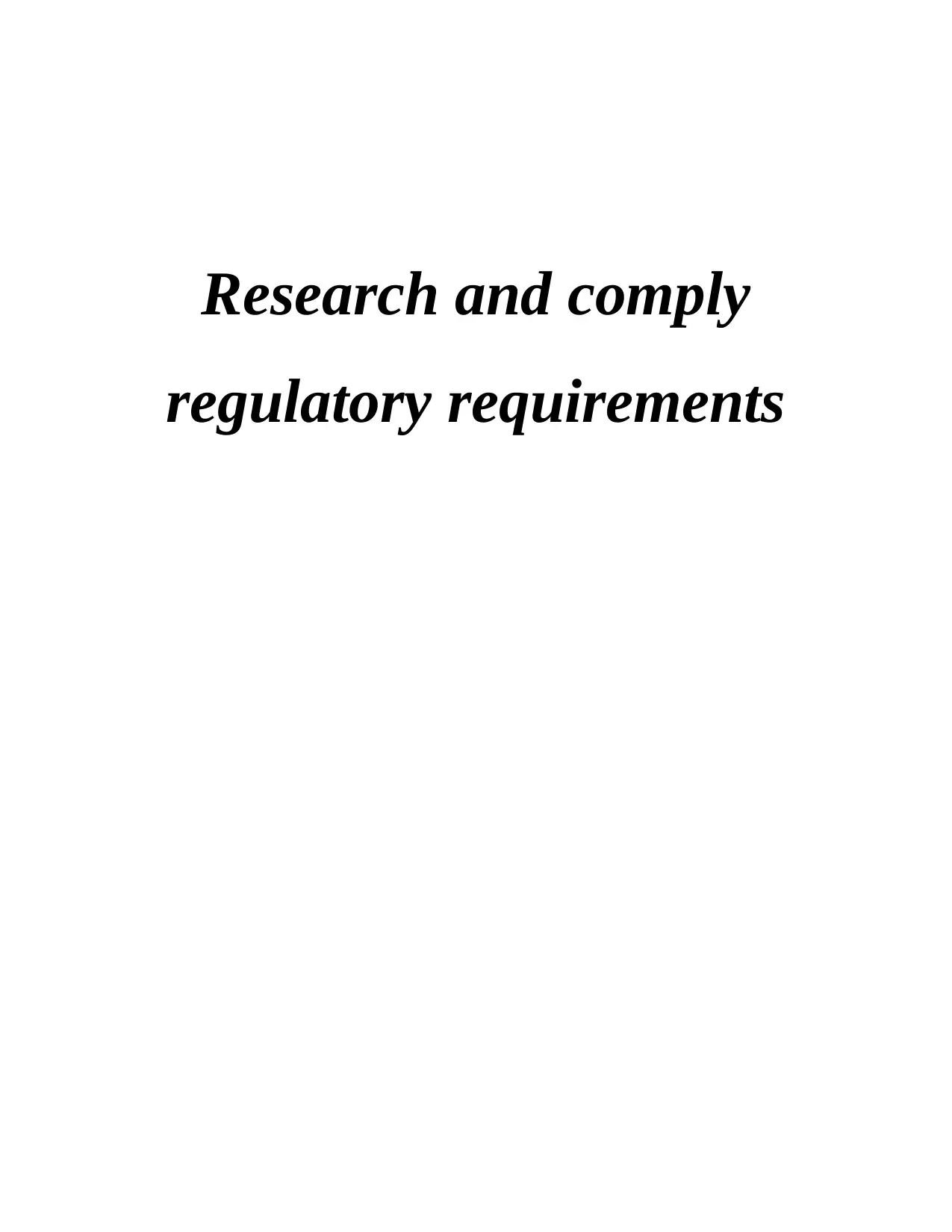
Research and comply
regulatory requirements
regulatory requirements
Paraphrase This Document
Need a fresh take? Get an instant paraphrase of this document with our AI Paraphraser
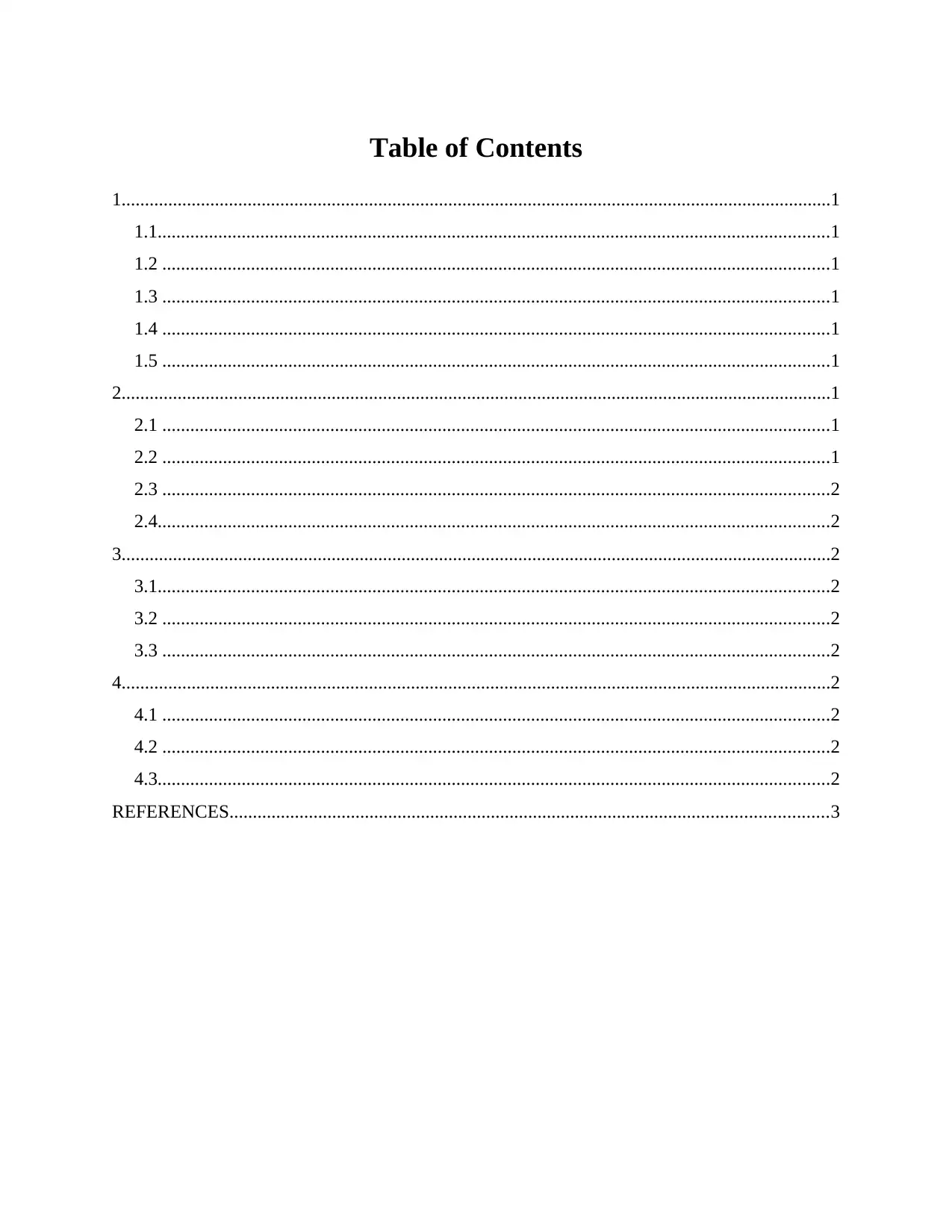
Table of Contents
1........................................................................................................................................................1
1.1................................................................................................................................................1
1.2 ...............................................................................................................................................1
1.3 ...............................................................................................................................................1
1.4 ...............................................................................................................................................1
1.5 ...............................................................................................................................................1
2........................................................................................................................................................1
2.1 ...............................................................................................................................................1
2.2 ...............................................................................................................................................1
2.3 ...............................................................................................................................................2
2.4................................................................................................................................................2
3........................................................................................................................................................2
3.1................................................................................................................................................2
3.2 ...............................................................................................................................................2
3.3 ...............................................................................................................................................2
4........................................................................................................................................................2
4.1 ...............................................................................................................................................2
4.2 ...............................................................................................................................................2
4.3................................................................................................................................................2
REFERENCES................................................................................................................................3
1........................................................................................................................................................1
1.1................................................................................................................................................1
1.2 ...............................................................................................................................................1
1.3 ...............................................................................................................................................1
1.4 ...............................................................................................................................................1
1.5 ...............................................................................................................................................1
2........................................................................................................................................................1
2.1 ...............................................................................................................................................1
2.2 ...............................................................................................................................................1
2.3 ...............................................................................................................................................2
2.4................................................................................................................................................2
3........................................................................................................................................................2
3.1................................................................................................................................................2
3.2 ...............................................................................................................................................2
3.3 ...............................................................................................................................................2
4........................................................................................................................................................2
4.1 ...............................................................................................................................................2
4.2 ...............................................................................................................................................2
4.3................................................................................................................................................2
REFERENCES................................................................................................................................3
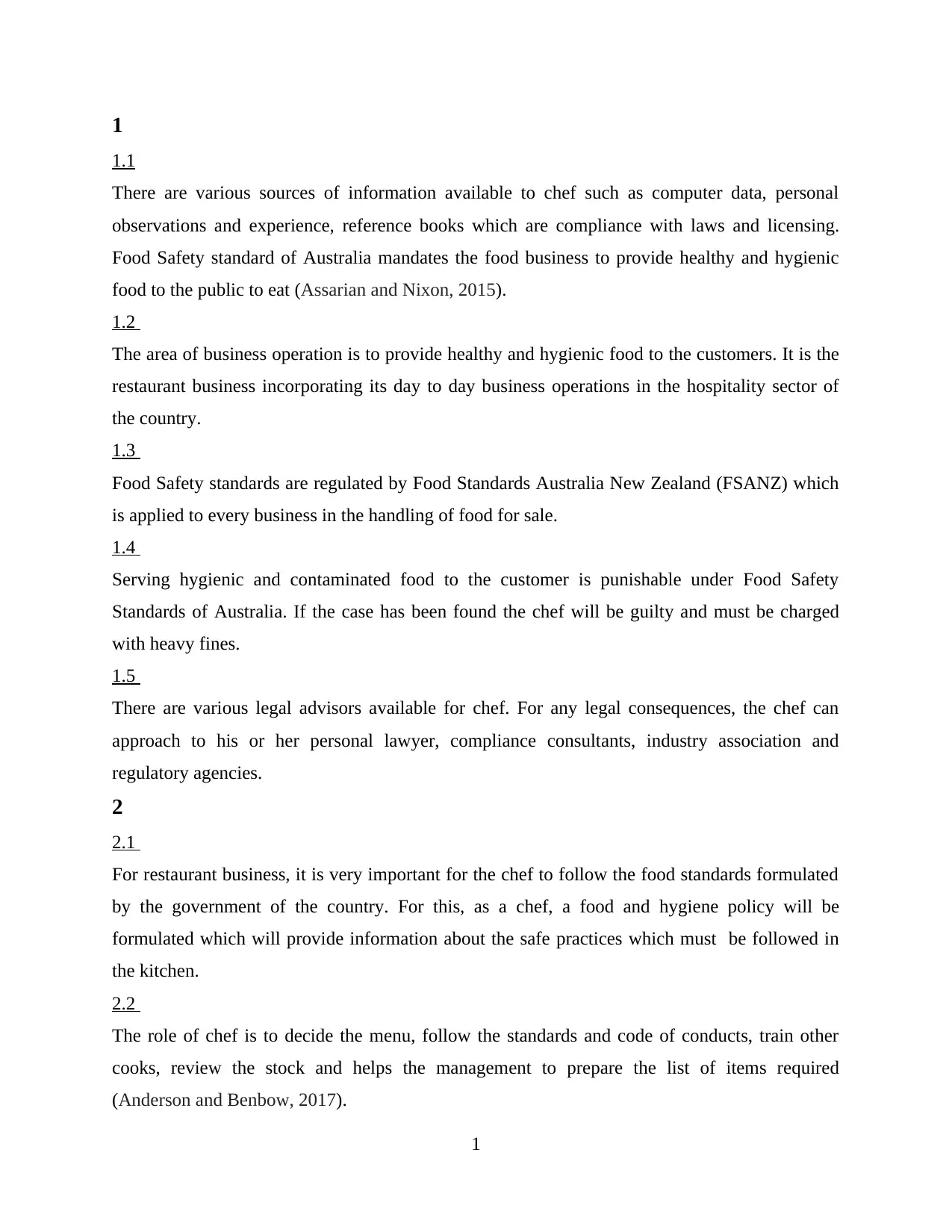
1
1.1
There are various sources of information available to chef such as computer data, personal
observations and experience, reference books which are compliance with laws and licensing.
Food Safety standard of Australia mandates the food business to provide healthy and hygienic
food to the public to eat (Assarian and Nixon, 2015).
1.2
The area of business operation is to provide healthy and hygienic food to the customers. It is the
restaurant business incorporating its day to day business operations in the hospitality sector of
the country.
1.3
Food Safety standards are regulated by Food Standards Australia New Zealand (FSANZ) which
is applied to every business in the handling of food for sale.
1.4
Serving hygienic and contaminated food to the customer is punishable under Food Safety
Standards of Australia. If the case has been found the chef will be guilty and must be charged
with heavy fines.
1.5
There are various legal advisors available for chef. For any legal consequences, the chef can
approach to his or her personal lawyer, compliance consultants, industry association and
regulatory agencies.
2
2.1
For restaurant business, it is very important for the chef to follow the food standards formulated
by the government of the country. For this, as a chef, a food and hygiene policy will be
formulated which will provide information about the safe practices which must be followed in
the kitchen.
2.2
The role of chef is to decide the menu, follow the standards and code of conducts, train other
cooks, review the stock and helps the management to prepare the list of items required
(Anderson and Benbow, 2017).
1
1.1
There are various sources of information available to chef such as computer data, personal
observations and experience, reference books which are compliance with laws and licensing.
Food Safety standard of Australia mandates the food business to provide healthy and hygienic
food to the public to eat (Assarian and Nixon, 2015).
1.2
The area of business operation is to provide healthy and hygienic food to the customers. It is the
restaurant business incorporating its day to day business operations in the hospitality sector of
the country.
1.3
Food Safety standards are regulated by Food Standards Australia New Zealand (FSANZ) which
is applied to every business in the handling of food for sale.
1.4
Serving hygienic and contaminated food to the customer is punishable under Food Safety
Standards of Australia. If the case has been found the chef will be guilty and must be charged
with heavy fines.
1.5
There are various legal advisors available for chef. For any legal consequences, the chef can
approach to his or her personal lawyer, compliance consultants, industry association and
regulatory agencies.
2
2.1
For restaurant business, it is very important for the chef to follow the food standards formulated
by the government of the country. For this, as a chef, a food and hygiene policy will be
formulated which will provide information about the safe practices which must be followed in
the kitchen.
2.2
The role of chef is to decide the menu, follow the standards and code of conducts, train other
cooks, review the stock and helps the management to prepare the list of items required
(Anderson and Benbow, 2017).
1
⊘ This is a preview!⊘
Do you want full access?
Subscribe today to unlock all pages.

Trusted by 1+ million students worldwide
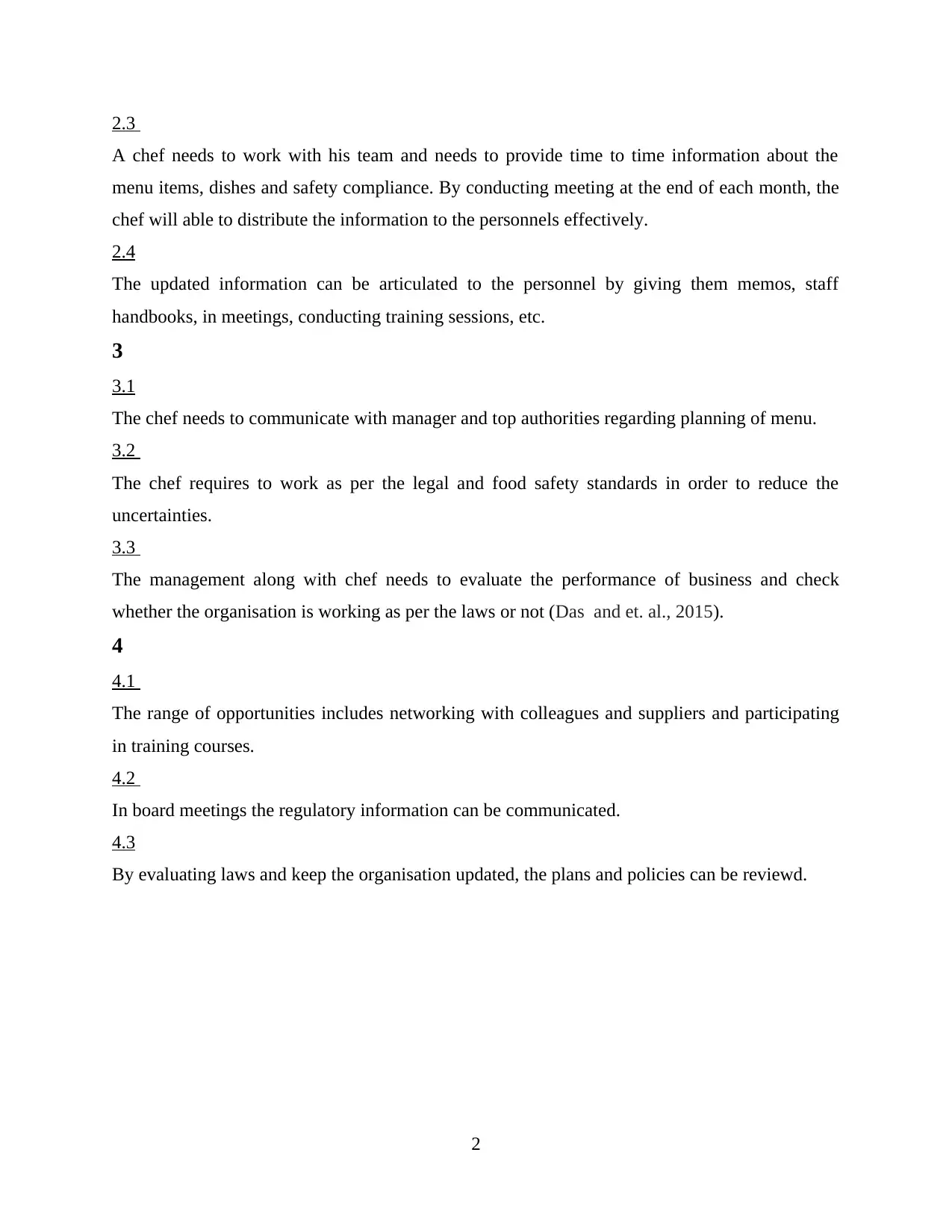
2.3
A chef needs to work with his team and needs to provide time to time information about the
menu items, dishes and safety compliance. By conducting meeting at the end of each month, the
chef will able to distribute the information to the personnels effectively.
2.4
The updated information can be articulated to the personnel by giving them memos, staff
handbooks, in meetings, conducting training sessions, etc.
3
3.1
The chef needs to communicate with manager and top authorities regarding planning of menu.
3.2
The chef requires to work as per the legal and food safety standards in order to reduce the
uncertainties.
3.3
The management along with chef needs to evaluate the performance of business and check
whether the organisation is working as per the laws or not (Das and et. al., 2015).
4
4.1
The range of opportunities includes networking with colleagues and suppliers and participating
in training courses.
4.2
In board meetings the regulatory information can be communicated.
4.3
By evaluating laws and keep the organisation updated, the plans and policies can be reviewd.
2
A chef needs to work with his team and needs to provide time to time information about the
menu items, dishes and safety compliance. By conducting meeting at the end of each month, the
chef will able to distribute the information to the personnels effectively.
2.4
The updated information can be articulated to the personnel by giving them memos, staff
handbooks, in meetings, conducting training sessions, etc.
3
3.1
The chef needs to communicate with manager and top authorities regarding planning of menu.
3.2
The chef requires to work as per the legal and food safety standards in order to reduce the
uncertainties.
3.3
The management along with chef needs to evaluate the performance of business and check
whether the organisation is working as per the laws or not (Das and et. al., 2015).
4
4.1
The range of opportunities includes networking with colleagues and suppliers and participating
in training courses.
4.2
In board meetings the regulatory information can be communicated.
4.3
By evaluating laws and keep the organisation updated, the plans and policies can be reviewd.
2
Paraphrase This Document
Need a fresh take? Get an instant paraphrase of this document with our AI Paraphraser
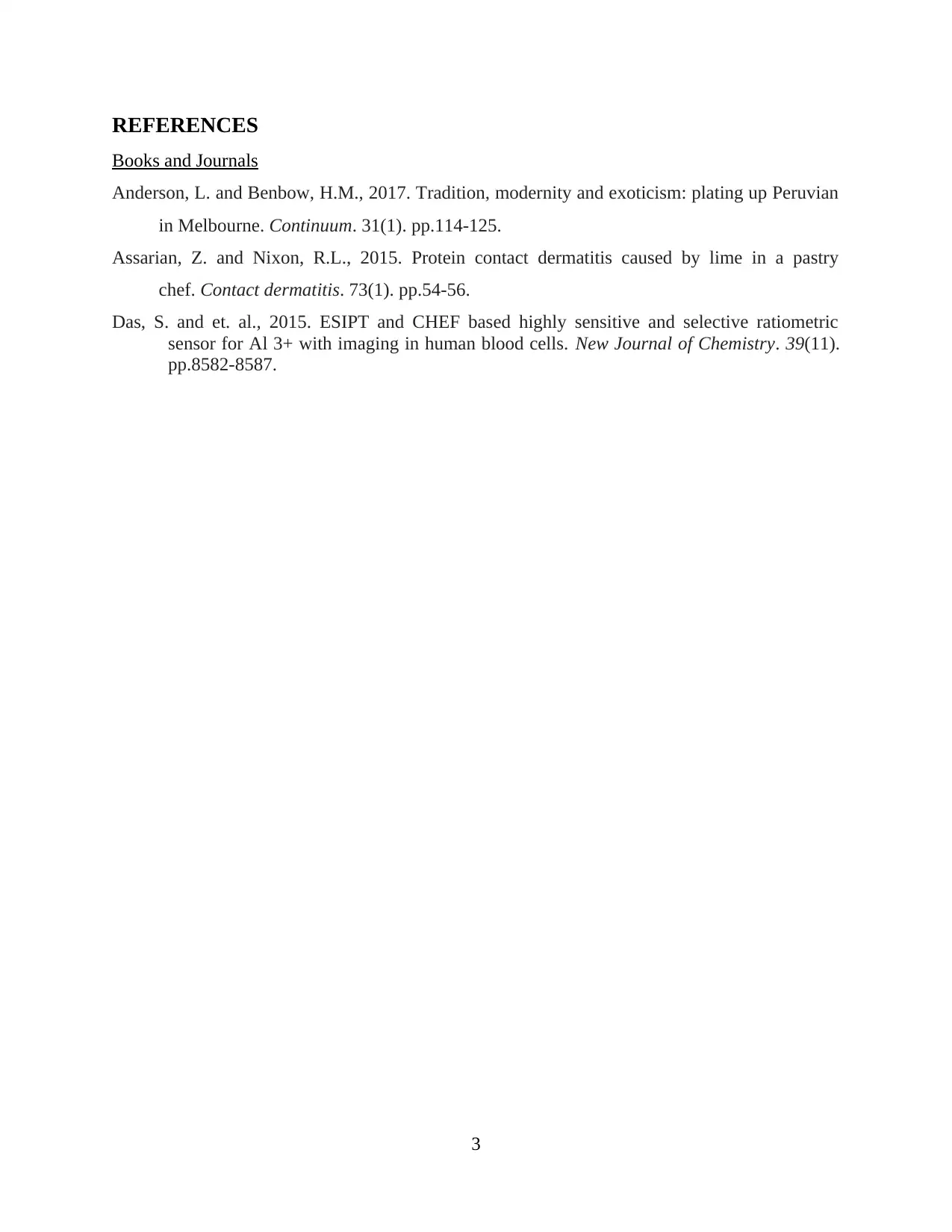
REFERENCES
Books and Journals
Anderson, L. and Benbow, H.M., 2017. Tradition, modernity and exoticism: plating up Peruvian
in Melbourne. Continuum. 31(1). pp.114-125.
Assarian, Z. and Nixon, R.L., 2015. Protein contact dermatitis caused by lime in a pastry
chef. Contact dermatitis. 73(1). pp.54-56.
Das, S. and et. al., 2015. ESIPT and CHEF based highly sensitive and selective ratiometric
sensor for Al 3+ with imaging in human blood cells. New Journal of Chemistry. 39(11).
pp.8582-8587.
3
Books and Journals
Anderson, L. and Benbow, H.M., 2017. Tradition, modernity and exoticism: plating up Peruvian
in Melbourne. Continuum. 31(1). pp.114-125.
Assarian, Z. and Nixon, R.L., 2015. Protein contact dermatitis caused by lime in a pastry
chef. Contact dermatitis. 73(1). pp.54-56.
Das, S. and et. al., 2015. ESIPT and CHEF based highly sensitive and selective ratiometric
sensor for Al 3+ with imaging in human blood cells. New Journal of Chemistry. 39(11).
pp.8582-8587.
3
1 out of 5
Related Documents
Your All-in-One AI-Powered Toolkit for Academic Success.
+13062052269
info@desklib.com
Available 24*7 on WhatsApp / Email
![[object Object]](/_next/static/media/star-bottom.7253800d.svg)
Unlock your academic potential
Copyright © 2020–2025 A2Z Services. All Rights Reserved. Developed and managed by ZUCOL.





